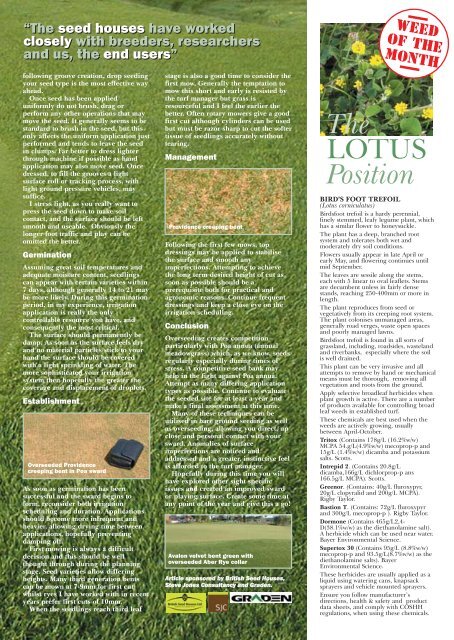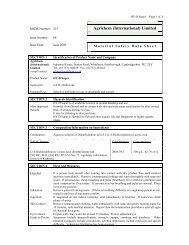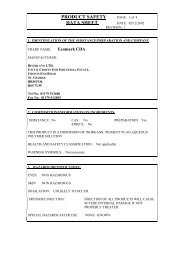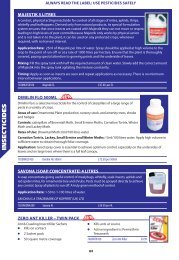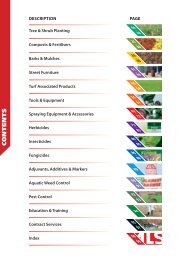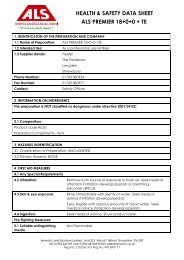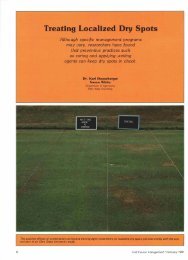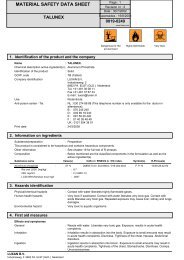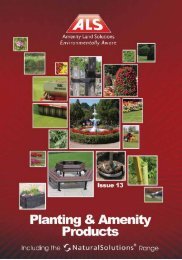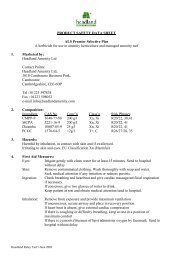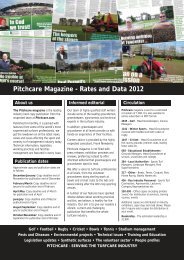3-in-1: Needle tine - Pitchcare
3-in-1: Needle tine - Pitchcare
3-in-1: Needle tine - Pitchcare
Create successful ePaper yourself
Turn your PDF publications into a flip-book with our unique Google optimized e-Paper software.
“The seed houses have worked<br />
closely with breeders, researchers<br />
and us, the end users”<br />
follow<strong>in</strong>g groove creation, drop seed<strong>in</strong>g<br />
your seed type is the most effective way<br />
ahead.<br />
Once seed has been applied<br />
uniformly do not brush, drag or<br />
perform any other operations that may<br />
move the seed. It generally seems to be<br />
standard to brush <strong>in</strong> the seed, but this<br />
only affects the uniform application just<br />
performed and tends to leave the seed<br />
<strong>in</strong> clumps. Far better to dress lighter<br />
through mach<strong>in</strong>e if possible as hand<br />
application may also move seed. Once<br />
dressed, to fill the grooves a light<br />
surface roll or track<strong>in</strong>g process, with<br />
light ground pressure vehicles, may<br />
suffice.<br />
I stress light, as you really want to<br />
press the seed down to make soil<br />
contact, and the surface should be left<br />
smooth and useable. Obviously the<br />
longer foot traffic and play can be<br />
omitted the better.<br />
Germ<strong>in</strong>ation<br />
Assum<strong>in</strong>g great soil temperatures and<br />
adequate moisture content, seedl<strong>in</strong>gs<br />
can appear with certa<strong>in</strong> varieties with<strong>in</strong><br />
7 days, although generally 14 to 21 may<br />
be more likely. Dur<strong>in</strong>g this germ<strong>in</strong>ation<br />
period, <strong>in</strong> my experience, irrigation<br />
application is really the only<br />
controllable resource you have, and<br />
consequently the most critical.<br />
The surface should permanently be<br />
damp. As soon as the surface feels dry<br />
and no material particles stick to your<br />
hand the surface should be covered<br />
with a light spr<strong>in</strong>kl<strong>in</strong>g of water. The<br />
more sophisticated your irrigation<br />
system then hopefully the greater the<br />
coverage and displacement of droplets.<br />
Establishment<br />
Overseeded Providence<br />
creep<strong>in</strong>g bent <strong>in</strong> Poa sward<br />
As soon as germ<strong>in</strong>ation has been<br />
successful and the sward beg<strong>in</strong>s to<br />
form, reconsider both irrigation<br />
schedul<strong>in</strong>g and duration. Applications<br />
should become more <strong>in</strong>frequent and<br />
heavier, allow<strong>in</strong>g dry<strong>in</strong>g time between<br />
applications, hopefully prevent<strong>in</strong>g<br />
damp<strong>in</strong>g off.<br />
First mow<strong>in</strong>g is always a difficult<br />
decision and this should be well<br />
thought through dur<strong>in</strong>g the plann<strong>in</strong>g<br />
stage. Seed varieties allow differ<strong>in</strong>g<br />
heights. Many third generation bents<br />
can be mown at 7-9mm for first cut<br />
whilst ryes I have worked with <strong>in</strong> recent<br />
years prefer first cuts of 10mm.<br />
When the seedl<strong>in</strong>gs reach third leaf<br />
stage is also a good time to consider the<br />
first mow. Generally the temptation to<br />
mow this short and early is resisted by<br />
the turf manager but grass is<br />
resourceful and I feel the earlier the<br />
better. Often rotary mowers give a good<br />
first cut although cyl<strong>in</strong>ders can be used<br />
but must be razor sharp to cut the softer<br />
tissue of seedl<strong>in</strong>gs accurately without<br />
tear<strong>in</strong>g.<br />
Management<br />
Providence creep<strong>in</strong>g bent<br />
Follow<strong>in</strong>g the first few mows, top<br />
dress<strong>in</strong>gs may be applied to stabilise<br />
the surface and smooth any<br />
imperfections. Attempt<strong>in</strong>g to achieve<br />
the long term desired height of cut as<br />
soon as possible should be a<br />
prerequisite both for practical and<br />
agronomic reasons. Cont<strong>in</strong>ue frequent<br />
dress<strong>in</strong>gs and keep a close eye on the<br />
irrigation schedul<strong>in</strong>g.<br />
Conclusion<br />
Overseed<strong>in</strong>g creates competition<br />
particularly with Poa annua (annual<br />
meadowgrass) which, as we know, seeds<br />
regularly especially dur<strong>in</strong>g times of<br />
stress. A competitive seed bank may<br />
help <strong>in</strong> the fight aga<strong>in</strong>st Poa annua.<br />
Attempt as many differ<strong>in</strong>g application<br />
types as possible. Cont<strong>in</strong>ue to evaluate<br />
the seeded site for at least a year and<br />
make a f<strong>in</strong>al assessment at this time.<br />
Many of these techniques can be<br />
utilised <strong>in</strong> bare ground seed<strong>in</strong>g as well<br />
as overseed<strong>in</strong>g, allow<strong>in</strong>g you direct, up<br />
close and personal contact with your<br />
sward. Anomalies of surface<br />
imperfections are noticed and<br />
addressed and a greater, <strong>in</strong>st<strong>in</strong>ctive feel<br />
is afforded to the turf manager.<br />
Hopefully dur<strong>in</strong>g this time you will<br />
have explored other sight specific<br />
issues and created an improved sward<br />
or play<strong>in</strong>g surface. Create some time at<br />
any po<strong>in</strong>t of the year and give this a go!<br />
Avalon velvet bent green with<br />
overseeded Aber Rye collar<br />
Article sponsored by British Seed Houses,<br />
Steve Jones Consultancy and Graden.<br />
WEED<br />
OF THE<br />
MONTH<br />
The<br />
LOTUS<br />
Position<br />
BIRD’S FOOT TREFOIL<br />
(Lotus corniculatus)<br />
Birdsfoot trefoil is a hardy perennial,<br />
f<strong>in</strong>ely stemmed, leafy legume plant, which<br />
has a similar flower to honeysuckle.<br />
The plant has a deep, branched root<br />
system and tolerates both wet and<br />
moderately dry soil conditions.<br />
Flowers usually appear <strong>in</strong> late April or<br />
early May, and flower<strong>in</strong>g cont<strong>in</strong>ues until<br />
mid September.<br />
The leaves are sessile along the stems,<br />
each with 5 l<strong>in</strong>ear to oval leaflets. Stems<br />
are decumbent unless <strong>in</strong> fairly dense<br />
stands, reach<strong>in</strong>g 250-400mm or more <strong>in</strong><br />
length.<br />
The plant reproduces from seed or<br />
vegetatively from its creep<strong>in</strong>g root system.<br />
The plant colonises unmanaged areas,<br />
generally road verges, waste open spaces<br />
and poorly managed lawns.<br />
Birdsfoot trefoil is found <strong>in</strong> all sorts of<br />
grassland, <strong>in</strong>clud<strong>in</strong>g, roadsides, wasteland<br />
and riverbanks, especially where the soil<br />
is well dra<strong>in</strong>ed.<br />
This plant can be very <strong>in</strong>vasive and all<br />
attempts to remove by hand or mechanical<br />
means must be thorough, remov<strong>in</strong>g all<br />
vegetation and roots from the ground.<br />
Apply selective broadleaf herbicides when<br />
plant growth is active. There are a number<br />
of products available for controll<strong>in</strong>g broad<br />
leaf weeds <strong>in</strong> established turf.<br />
These chemicals are best used when the<br />
weeds are actively grow<strong>in</strong>g, usually<br />
between April-October.<br />
Tritox (Conta<strong>in</strong>s 178g/L (16.2%w/w)<br />
MCPA 54.g/L(4.9%w/w) mecoprop-p and<br />
15g/L (1.4%w/w) dicamba and potassium<br />
salts. Scotts.<br />
Intrepid 2. (Conta<strong>in</strong>s 20.8g/L<br />
dicamba,166g/L dichlorprop-p ans<br />
166.5g/L MCPA). Scotts.<br />
Greenor. (Conta<strong>in</strong>s: 40g/L fluroxypyr,<br />
20g/L clopyralid and 200g/L MCPA).<br />
Rigby Taylor.<br />
Bastion T. (Conta<strong>in</strong>s: 72g/L fluroxypyr<br />
and 300g/L mecoprop-p ). Rigby Taylor.<br />
Dormone (Conta<strong>in</strong>s 465g/L2,4-<br />
D(38.1%w/w) as the diethanolam<strong>in</strong>e salt).<br />
A herbicide which can be used near water.<br />
Bayer Environmental Science.<br />
Supertox 30 (Conta<strong>in</strong>s 95g/L (8.8%w/w)<br />
mecoprop-p and 93.5g/L(8.7%w/w) as the<br />
diethanolam<strong>in</strong>e salts). Bayer<br />
Environmental Science.<br />
These herbicides are usually applied as a<br />
liquid us<strong>in</strong>g water<strong>in</strong>g cans, knapsack<br />
sprayers and vehicle mounted sprayers.<br />
Ensure you follow manufacturer’s<br />
directions, health & safety and product<br />
data sheets, and comply with COSHH<br />
regulations, when us<strong>in</strong>g these chemicals.


